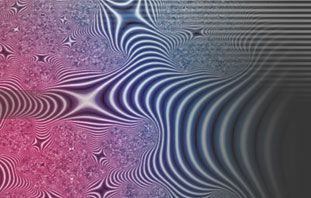|
What’s the story Chris Cowan tells about the colors?
Chris tells this tongue-in-cheek story about how he selected the colors for the Gravesian levels:
“The credit goes to Dr. PH Martin, manufacturer of fine aniline pigments. Back in the 1970s when we first began working with the model I manufactured title slides in the darkroom using Kodalith Ortho film, a high contrast product with a high D-max producing opaque blacks and clear whites. However, the white (clear) is stark onscreen, thus color is used to temper it. One approach is to sandwich Roscolene or equivalent. Another is simply to paint color directly on the film with a fine brush (#0 to 000) using a product such as, Dr. PH Martin's Synchromatic Transparent Water Colors. The set of 24 colors comes in a nice fitted box. The pigments are grouped by colors.
When I produced the first set of Kodalith title slides portraying the emergent, cyclical point of, I came to a critical decision point. Since there were seven systems at that point, there could be distinct colorings for each one, thus making a more attractive set of Kodaliths. So, a meditation...
Oh, Muse! Where art thou? Sing of pigmentations, of bringing light to Graves, of distillates of indigo. Sing of choosing shades the fit, the essence of thinking portrayed in Angstrom lengths. Promethean task...but WAIT! Thank you, Muse! Revelation clear has to mine eyes appeared. Dr. Martin offers up the way; he guides the hand around the wheel of light.
Let the express and sacrifice become distinct. But how? The primaries are three; so falls the gentler triad of secondaries—cyan, yellow, magenta. What can be done, oh guide of
colorimetrics? Elementary thought—elementary school—warm and cool, cold and hot. Dichotomy, not trinity. Separate the bottles.
But the complexities abound. How to distinguish the subtler steps, the seven themes that play beneath this music of the biopsychosocial spheres? Which warm, which cool? How to choose...a weighty matter.…
The chakras? Not considered. Luscher? Cute, old, irrelevant. The schemes are myriad, but none doth fit. What to do...
Olympian inspiration! Let Dr. Martin decide! His tiny bottles, elixir for the optic nerve, are lined up in the package as it sits, glancing at each other but declining to mix without human intervention. Just bring them to hand, you say.
Open the lid the keeps the glowing shades confined within. Hair of the camel dipped gently through the shimmering ring held fast by molecular hands asking only to keep surface intact. Broken bonds...they must share. Grasp but a drop and touch it to film. Too much and the fluid gains a life of its own, running like winged Mercury across the frame to dribble into space, sharing its aniline permanence with whatever lies beneath. Trousers ruined. Drat. Too little and the gods see only whiteness on slides become like images being viewed by Icarus, fading in Kodak's broiling sun as wings collapse while he's changing trays.
So, what must this say? How shall we paint a theory? Oh, Muse, again we seek your guidance.
Ah, beige is the color of dried grasses, the likely home of hominids migrating into humanness. It is the color of hides, of nature with chlorophyl, light-lover of the plant realm, departed. It is on the left side of Dr. Martin's box. Use it, you say. This is the beginning.
The doctor also offers a clue to what came next as these neo-humans used color of their own: purple, the royal hue. No longer the earthy tones of clay and stone but berries and bugs crushed, liberated, turned artistic. Likely the shade of Joseph's coat, then accented by ermine below. Crowned heads, mortals seeking immortality through dye. Then, as alchemists' thoughts of gold turned to other colors in the centuries to come, also the first commercial aniline, the dye of dyes that evolved to do so much for the petrochemical revolution.
But what of the third level, the egocentric land of raw assertion. Easy choice. Red, rojo, chillis -- the color you can taste, which fills the eyes when emotion surges. Blood. Rage. Alarm. Urgency. Passion. Yes, red.
The gods themselves bespoke the next. Look up from the paint box and out the window. The darkness of space is made blue as Sol confronts another trinity—earth, air, fire. The heavens, if above they are, are thus.
Now across the bridge to expressiveness, but softer than red. What can it be? If the sun shining from the blue sky falls upon the red, what might this become? Dr. Martin prescribed that orange would be the transition. And, lo, it fit the fires of industry, the glow of the furnace, the vibrant heat of glass that is still maleable, willing, fluid; no longer the surly glow of red that burns but does not yield, but a supplicant asking for change and transformation.
Now, chlorophilia, let the green emerge! 'Twas clear that the rapacious fires of the machine age would yield to gentle nature and, once again, the fields be ripe with organic bounty. Synthesis not synthetics. Even before the Greens were green (but after the Greening of America), Dr. Martin bespoke this color.
Graves dictated the last. If beige be the beginning, then what lies beyond the
hectave, the momentous A'-N' if such it be, the 7th if the step across be not so monumental? Beige revisited…grasses raised to the heights through the blue…fingers swaying in supplication to the solar wind. The man-made fires turned nuclear. Yellow.
With apologies to Dr. Martin, Dr. Graves' theory prevailed in subsequent color choices as new slides evolved and we became more conscious of other levels of being. The logic of the dye set said another version of purple for the B'-O', but the logic of then-noteworthy photos said otherwise. It was the time when pictures of earth from moon were news, when Apollo was both god and mission, when "the blue ball" was being popularized as a borderless whole for the first time, and Cousteau excited the depths of popular imagination by going down on the planet, itself.
The next color, when title slides are warranted, will be coral, a color found beneath that blue sky retinted and reflected by the life in the sea. Sort of a red redux, but made gentler and alive. Also in jeopardy. The second tier seems to lend itself to more "secondary" tones, softer notes that fit between the harsh, primary subsistence sounds. Some would argue that saffron is a better choice, but that's as yet unclear, and Dr. Martin has yet to speak.
So, that's the story of colors.”
|


